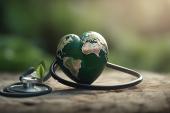Medical Imaging Has a Climate Problem: Radiologists Outline a Plan
Coinciding with Earth Day, a new paper tackles how imagers can improve sustainability, while preparing for environmental crises.

Radiologists—and indeed, all healthcare professionals—can take steps to both lessen the detrimental environmental effects of medical imaging and prepare for the inevitable consequences of climate change, according to a review published to coincide with Earth Day 2024.
“This specific paper was really motivated by a desire to expand the discussion beyond just how much energy do we use in imaging, for example, to kind of the bigger picture,” senior author Kate Hanneman, MD (University of Toronto, Canada), a cardiothoracic imager, told TCTMD, alluding to downstream effects on patients and other impacts. It touches on “that whole planetary health concept and bringing that to radiology.”
Although the focus of the paper is on imaging, including cardiac imaging, the recommendations apply to the practice of cardiology more broadly, Hanneman said. She pointed, for example, to minimizing greenhouse gas emissions both upstream in the supply chain and downstream when it comes to waste disposal. “All of us as health professionals can play a role in improving sustainability,” she said, stressing that “this ideally shouldn’t be done by one person or in isolation. We really want to engage people, and part of that is providing education on what the benefits are to making these changes, whether they’re big or small.”
Mounting evidence shows that climate change is having harmful health effects, including in the realm of cardiovascular disease. Radiology alone has been estimated to generate up to 1% of all greenhouse gas emissions, related to production and use of medical imaging equipment and other supplies, the review authors note. And cardiac imaging specifically comes with a large carbon footprint, as highlighted before.
Hanneman said a key message of the new review, published online this week in a sustainability-themed issue of Radiology with lead author Hayley McKee, MSc (University of Toronto), “is that human health and the health of the planet are connected. Why we should care as physicians or other healthcare professionals is that, of course, our main goal in delivering healthcare is to achieve health in the patients that we serve.”
Our main goal in delivering healthcare is to achieve health in the patients that we serve. Kate Hanneman
In the current review, McKee, Hanneman, and colleagues outline ways in which radiologists can tackle environmental sustainability issues in their field from the perspectives of mitigating imaging’s impacts and preparing for the downstream effects of a changing climate, which might include an uptick in the number of patients requiring treatment for various conditions or damage to medical infrastructure.
In terms of strategies to reduce greenhouse gas emissions tied to CT, MRI, or other types of imaging, the author highlight “switching to renewable energy sources, refurbishing rather than replacing imaging scanners, and powering down scanners when not in use.”
In addition, they say, abbreviating imaging protocols may have benefits. A separate research letter, with Hanneman as senior author and Fadi Ibrahim, MD (University of Toronto), as lead author, evaluated the impact of an abbreviated MRI protocol that largely eliminated idle time during imaging. The change was associated with an 18% reduction in total scan duration, a 19% reduction in energy use, and a 19% reduction in greenhouse gas emissions. If such a protocol were implemented across the United States for 1 year, that reduction in greenhouse gas emissions would be the equivalent of avoiding 538,345 miles driven by an average passenger vehicle, they estimate.
“That’s a lot, and that’s just one protocol change for cardiac MR, so you could imagine if we made other changes at the same time, these savings and sustainability improvements would be additive,” Hanneman said.
Building Resiliency
The authors also underscore the need for health systems and radiology departments to prepare for the impacts of climate change through both education and infrastructure improvements.
When it comes to resiliency, “probably the key message that I’d want people to be aware of, definitely in the cardiology community, is that there are health impacts of climate change—and this includes extreme temperatures and poor air quality, for example—and we know based on prior literature that that can impact cardiovascular outcomes,” Hanneman said.
In this context, centers need to start thinking about a need for increased imaging after a bad wildfire season, for example, or how to ensure that they’re prepared for an extreme weather event like a hurricane, she said.
“Sustainability in radiology requires a coordinated approach to partner with key stakeholders, communicate effectively, and prioritize high-impact interventions,” Hanneman and her colleagues write. Examples of such interventions include the creation of environmental sustainability teams and dashboards to track progress; a switch from single-use to reusable supplies; and shutting off climate control systems in unoccupied rooms and powering down equipment when it’s not being used. Some of these also come with cost savings, Hanneman said.
Todd Neale is the Associate News Editor for TCTMD and a Senior Medical Journalist. He got his start in journalism at …
Read Full BioSources
McKee H, Brown MJ, Kim HHR, et al. Planetary health and radiology: why we should care and what we can do. Radiology. 2024;311(1):e240219.
Ibrahim F, Cadour F, Campbell-Washburn AE, et al. Energy and greenhouse gas emission savings associated with implementation of an abbreviated cardiac MRI protocol. Radiology. 2024;311(1):e240588.
Disclosures
- Hanneman reports receiving honoraria from Sanofi and being associate editor for Radiology and Radiology: Cardiothoracic Imaging.
- Ibrahim and McKee report no relevant conflicts of interests.





Comments